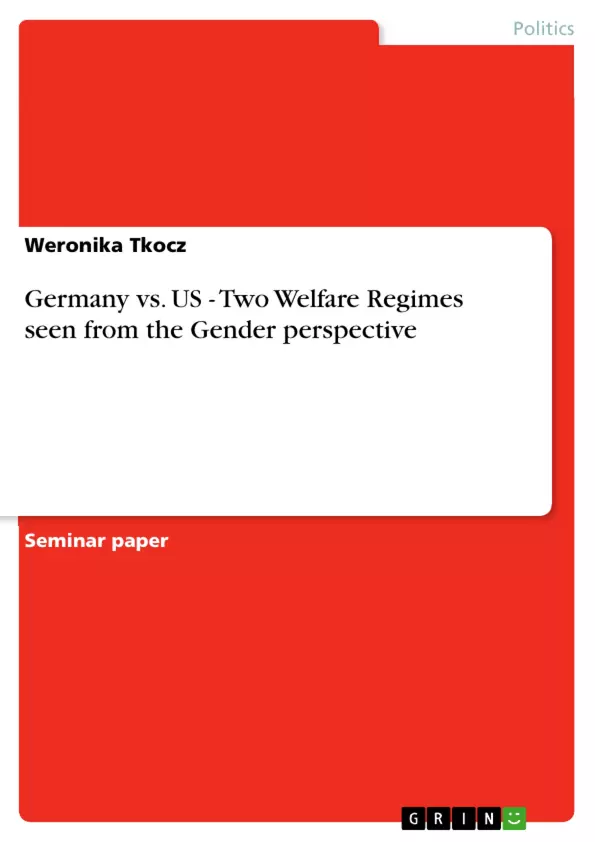This paper deals with the problem of the welfare state in two states subordinated to two different welfare regimes: conservative-corporatist (Germany) and liberal regime (United States). Having in mind, that this a very wide and multidimensional problematic, it will be limited only to the changes in welfare systems mainly in the 1990s seen from the perspective of gender relations and women′s situation in welfare.
In short, this paper will focus on the German reunification and the changes it exerted on the women′s situation in former GDR. Then it will present briefly policy towards women and families under Chancellor KOHL′s governance. Regarding the USA, welfare reform of 1996 will mainly be discussed - the Personal Responsibility Act - preparations, contents, and the effect. Afterwards, the reaction of the feminist societies on the changes in the American welfare will be presented.
Before the main part, as a starting point, the differences between Germany and the US as two states representing two different welfare regimes will be briefly presented. This comparison will be based on the ESPING-ANDERSEN model that was introduced to the study of welfare at the beginning of 1990′s. The feminist critique on basic assumptions of ESPING-ANDERSEN′s classification shall not also be omited.
Inhaltsverzeichnis (Table of Contents)
- INTRODUCTION
- GERMANY AND THE UNITED STATES: CONSERVATIVE-CORPORATISM VERSUS LIBERALISM
- CRITIQUE ON THE ESPING-ANDERSEN MODEL
- GERMANY IN THE 1990'S: BETWEEN REUNIFICATION AND POWER EXCHANGE ON THE TOP
- THE IMPACT OF REUNIFICATION ON WOMEN IN THE EAST
- GERMANY REUNITED, SECOND HALF OF KOHL'S ERA
- UNITED STATES: REFORM OF THE WELFARE SYSTEM
- THE PERSONAL RESPONSIBILITY AND WORK OPPORTUNITY RECONCILIATION ACT 1996
- THE FEMINIST CRITIQUE
- CONCLUSIONS
- LITERATURE
Zielsetzung und Themenschwerpunkte (Objectives and Key Themes)
This paper examines the welfare state in two countries, Germany and the United States, representing different welfare regimes: conservative-corporatist and liberal respectively. The analysis focuses on changes in welfare systems during the 1990s, particularly as they relate to gender relations and women's experiences within these systems.
- Impact of German reunification on women in the former GDR
- Policy towards women and families during Chancellor KOHL's governance in Germany
- Welfare reform in the United States in 1996, including the Personal Responsibility Act
- Feminist critique of changes in the American welfare system
- Comparison of the conservative-corporatist and liberal welfare models based on the ESPING-ANDERSEN framework
Zusammenfassung der Kapitel (Chapter Summaries)
The paper begins by contrasting the German and American welfare systems, highlighting their distinct approaches to state intervention and social provision. This analysis draws on the ESPING-ANDERSEN model, which categorizes welfare states into three types: liberal, conservative-corporatist, and social-democratic.
Subsequent sections delve into specific developments within each country. In Germany, the focus is on the impact of reunification on women in the former East, as well as policies implemented during Chancellor KOHL's era. These sections explore the interplay between welfare policies and gender roles in the context of German reunification and political shifts.
The discussion then turns to the United States, examining the 1996 welfare reform and its implications for women. This section analyzes the Personal Responsibility and Work Opportunity Reconciliation Act, its feminist critique, and the resulting changes in the American welfare landscape.
Schlüsselwörter (Keywords)
The primary focus of this paper is the analysis of the welfare state in Germany and the United States from a gender perspective. Key concepts include welfare regimes, conservative-corporatism, liberalism, gender relations, women's situation, German reunification, welfare reform, the Personal Responsibility Act, feminist critique, and the ESPING-ANDERSEN model.
- Arbeit zitieren
- Weronika Tkocz (Autor:in), 2002, Germany vs. US - Two Welfare Regimes seen from the Gender perspective, München, GRIN Verlag, https://www.hausarbeiten.de/document/8584


